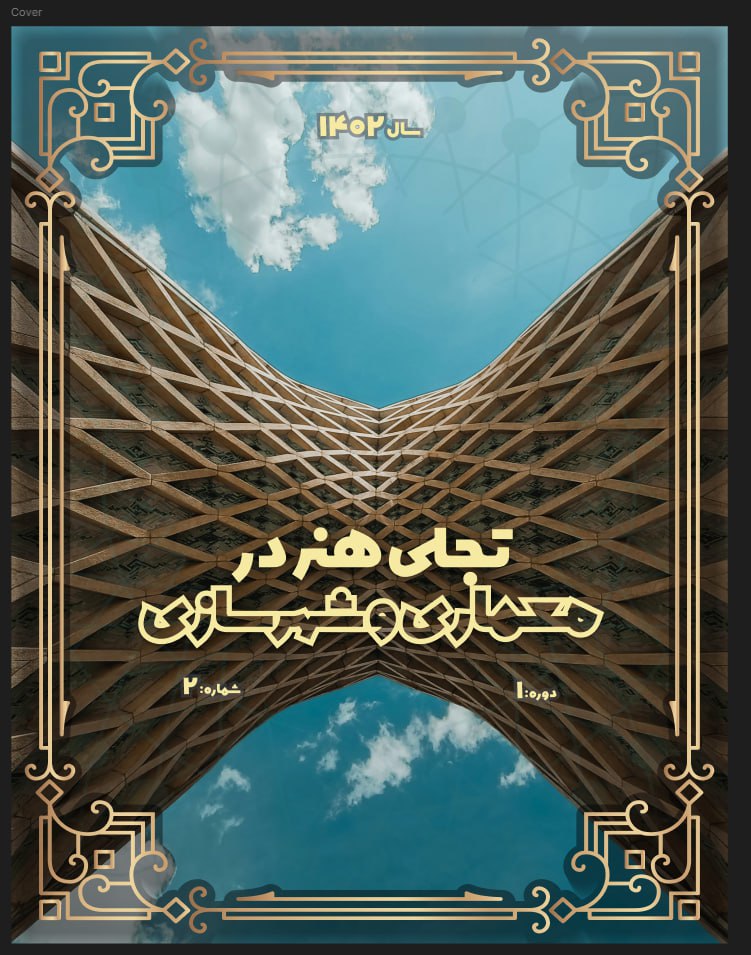Patterns of Explaining Contemporary Architecture in 12 Books on Architectural History
Keywords:
Architectural History, Contemporary Architecture, Architectural Historiography, Architectural Analysis PatternsAbstract
This study seeks to identify the common analytical patterns and contextual frameworks employed in constructing narratives of architecture. Using a comparative analytical method, twelve influential books in the history of contemporary architecture were examined. The analysis was structured around three main criteria: approaches to history, contextual frameworks, and patterns of physical analysis. For each book, the content, structure, and analytical methods were studied, and the common patterns as well as differences were identified. The analyses revealed that the approaches used in the examined books can be divided into four main categories: analytical, descriptive, design-oriented, and historical. The identified contextual frameworks included cultural, historical, social, economic, technological, natural, formal, philosophical, and political dimensions. The physical analysis patterns included spatial analysis, aesthetic analysis, structural analysis, and climatic considerations. The emphasis on each of these dimensions varies across different books, and these variations influence the interpretation of architectural works. Ultimately, the books were classified into four main categories based on methodological approaches: (1) design-oriented books, such as The Story of Architecture, which emphasize the practical and creative aspects of architectural design; (2) historically and analytically oriented books, such as Theories of Modern Architecture, which explore the historical roots and theoretical foundations of architecture; (3) books with a combined approach, such as History of Architecture Based on a Comparative Method, which were categorized under comprehensive studies and employ multiple approaches—analytical, descriptive, design-oriented, and historical; and (4) books focused on modern architecture, such as History of Modern Architecture, which concentrate on the modern period or specific subjects like postmodernism and are suitable for readers interested in these eras. This classification helps readers choose suitable books based on their needs and interests, whether they seek comprehensive studies, historical analyses, practical knowledge, or focus on a specific period. The study demonstrates that the historiography of contemporary architecture is moving toward multifaceted and interdisciplinary approaches. The diversity in approaches and analytical frameworks enables a deeper and more comprehensive understanding of contemporary architecture. The findings of this study may be applied to improve teaching methods and develop curricular materials in the field of architectural history. It is recommended that future research examine the impact of these diverse approaches on students’ understanding of architectural history. The main limitation of this research was its focus on a limited number of architectural history books, which can be addressed in future studies by expanding the range of sources under review.
Downloads
References
1. Frampton K. Modern architecture: a critical history. 2007.
2. Payne AA. Architectural history and the history of art: a suspended dialogue. Journal of the Society of Architectural Historians. 1999;58(3):292-9.
3. Scruton R, Gowans A, Collins P, Ackerman JS. Architecture . Encyclopedia Britannica [Available from: https://www.britannica.com/topic/architecture.
4. Jones CB. The Role of the Architect: Changes of the Past, Practices of the Present, and Indications of the FutureCY - Provo (UT): Brigham Young University; 2006.
5. Arnold D. Reading the past: What is architectural history?BT - Reading Architectural History. Routledge; 2003. p. 1-13.
6. Al-Hammadi NAQ, Grchev K. Aspects of contextual architecture regarding traditional/contemporary architecture, physical/cultural and place identity: a systematic literature review. Open House International. 2023;48(1):119-40.
7. Giedion S. Space, time and architecture: The growth of a new tradition: Harvard University Press; 1941.
8. Le Corbusier. Towards a new architecture. London: Architectural Press; 1963.
9. Ehteshami A. Historical Perception of Architecture and Cultural History Approach. Art and Design Review. 2018;6:76-95.
10. Stanford M. An Introduction to the Study of History. Tehran: SAMT Publications; 2013.
11. Zarrinkoub A. History in the Balance: On Historical Perspective and Historiography. Tehran: Amirkabir Publications; 2018.
12. Luebering J. History. Encyclopedia Britannica [Available from: https://www.britannica.com/topic/history1.
13. Carr EH. What Is History? Tehran: Kharazmi Publications; 2008.
14. Ranjbar Kermani AM. Improving the Efficiency of Teaching Architectural History. Journal of Iranian Architecture Studies. 2022;9(18):5-24.
15. Vann RT. historiography. Encyclopedia Britannica [Available from: https://www.britannica.com/topic/historiography.
16. Fletcher B, Fletcher B. A History of Architecture on the Comparative Method. London: RIBA; 2019.
17. Ware WR. The American Vignola: A Guide to the Making of Classical Architecture. New York: Dover Publications; 2012.
18. Jencks C. The Language of Post-modern Architecture. Taiwan: Academy Editions; 1984.
19. Venturi R, Brown DS, Izenour S. Learning from Las Vegas: MIT Press; 1972.
20. Jarzombek MM, Prakash V. A Global History of Architecture. Germany: Wiley; 2011.
21. Herz M, Schröder I, Focketyn HAUJJ. African Modernism: The Architecture of Independence. Ghana, Senegal, Côte D'Ivoire, Kenya, Zambia. Zurich: Park Books; 2022.
22. Ronsivalle D. Relevance and Role of Contemporary Architecture Preservation-Assessing and Evaluating Architectural Heritage as a Contemporary Landscape: A Study Case in Southern Italy. Sustainability. 2023;15(5):4132.
23. Hartoonian G. Time, History and Architecture: Essays on Critical Historiography: Routledge; 2017.
24. Tournikiotis P. The Historiography of Modern Architecture. United Kingdom: Penguin Random House LLC; 2001.
25. Scully V. American architecture and urbanism: Praeger; 1969.
26. Eisenman P. The End of the Classical: The End of the Beginning, the End of the End. Perspecta. 1984;21:154-72.
27. Pallasmaa J. The eyes of the skin: Architecture and the senses: John Wiley & Sons; 2005.
28. Charleson A. Structure as architecture: A source book for architects and structural engineers: Architectural Press; 2018.
29. Bellini Ó E, Vila MG. Bioclimatic architecture: Innovative designs for habitability and environmental health: Springer; 2019.
30. Kostof S, Castillo G. A History of Architecture: Settings and Rituals. New York: Oxford University Press; 1995.
31. Mozayeni M. Of Time and Architecture. Tehran: Shahidi Publications; 2007.
32. Ghobadian V. Foundations and Concepts in Contemporary Western Architecture. Tehran: Cultural Research Bureau Publications; 2003.
33. Curtis WJR. Modern Architecture Since 1900. London: Phaidon; 1996.
34. Benevolo L. History of Modern Architecture. Cambridge: M.I.T. Press; 1977.
35. Mallgrave HF. Modern Architectural Theory: A Historical Survey, 1673-1968. Cambridge: Cambridge University Press; 2009.
36. Collins P. Changing Ideals in Modern Architecture, 1750-1950. Ithaca: McGill-Queen's University Press; 1998.
37. Bani Masoud A. Postmodernity and Architecture. Isfahan: Khak Publishing; 2007.
38. Magnago Lampugnani V. The Thames and Hudson Encyclopedia of 20th Century Architecture. London: Thames and Hudson; 1986.
39. Conway H, Roenisch R. Understanding Architecture: An Introduction to Architecture and Architectural History. London: Routledge; 1994.
40. Glancey J. The Story of Architecture. London: Dorling Kindersley; 2017.
Downloads
Published
Submitted
Revised
Accepted
Issue
Section
License
Copyright (c) 2025 Mahnaz Moeini-Saleh; Mehdi Hamzehnejad, Farhang Mozaffar (Author)

This work is licensed under a Creative Commons Attribution-NonCommercial 4.0 International License.









